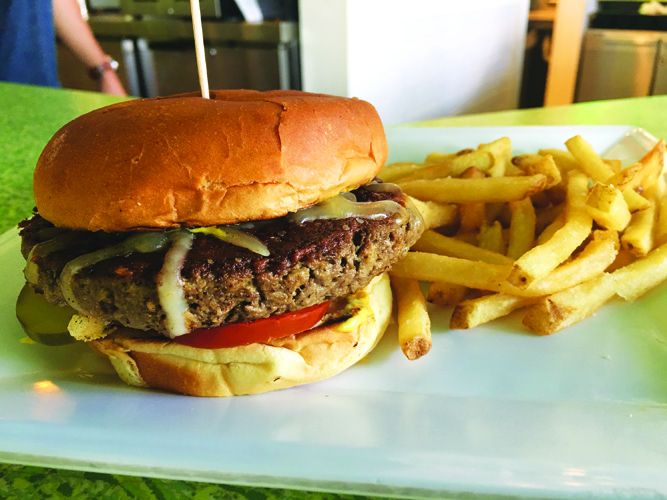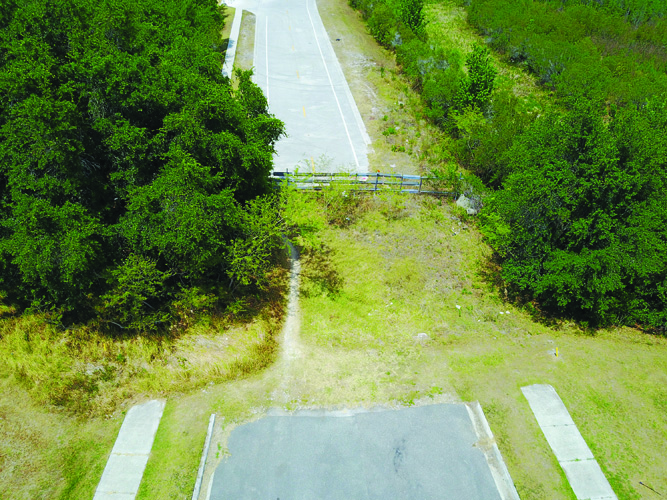 Ciccio Restaurant Group’s Jeff Gigante is on a mission — to prove to the world that a meatless, 100-percent plant-based burger, including a secret ingredient called “heme” that you’ve almost certainly never heard of, can not only help save the planet, but taste good as well.
Ciccio Restaurant Group’s Jeff Gigante is on a mission — to prove to the world that a meatless, 100-percent plant-based burger, including a secret ingredient called “heme” that you’ve almost certainly never heard of, can not only help save the planet, but taste good as well.
And, that’s not just good for a “veggie” burger, which would be a low bar to clear.
But good good…like a “real” hamburger.
“We’re going after carnivores, not vegans and vegetarians,’’ Gigante said.
The night before the beef-free Impossible Burger made its debut in Florida at eight of Gigante’s restaurants, including the New Tampa Ciccio Cali, Gigante promised us we’d be blown away.
“It will change your life,’’ he said.
It has certainly changed his.
 Since touring the Impossible Foods facility in California last year, Gigante has been obsessed with bringing the Impossible Burger to his restaurants. He beat out many others also eager to unveil the burger outside of food meccas like New York and Las Vegas. “It has taken me a year, and I did it,’’ Gigante said.
Since touring the Impossible Foods facility in California last year, Gigante has been obsessed with bringing the Impossible Burger to his restaurants. He beat out many others also eager to unveil the burger outside of food meccas like New York and Las Vegas. “It has taken me a year, and I did it,’’ Gigante said.
Impossible Foods, headquartered in Redwood City, CA, was founded by Stanford University biochemistry professor Patrick Brown in 2011. After spending an 18-month sabbatical working to eliminate industrial animal agriculture because of its negative effects on the environment, Brown decided the best way to work towards solving the problem was by creating products that did so, including a plant-based burger that looks, smells and tastes like ground beef.
Heme, a molecule in blood that makes it red (and makes meat look pink), is the key ingredient (and derived from the roots of a soy plant) that helps make the Impossible Burger burger-ish. The rest of the burger is intricately comprised of various plant, wheat and potato proteins that most mimic the smells, taste and texture of ground beef.
 The Impossible Burger launched last year in NY and Los Angeles. According to the company, the burger uses 95% less land, 74% less water and emits 87% less greenhouse gases than a burger made from cows – the livestock industry is known for requiring an abundance of food, water and land.
The Impossible Burger launched last year in NY and Los Angeles. According to the company, the burger uses 95% less land, 74% less water and emits 87% less greenhouse gases than a burger made from cows – the livestock industry is known for requiring an abundance of food, water and land.
It also has more protein and less fat and calories and is free of cholesterol, antibiotics and synthetic hormones (although it does have more sodium and more saturated fats). A 3-ounce Impossible Burger patty has 220 calories, 13 grams of total fat (but no trans fat), 5 carbs and 20 grams of protein.
“It really is a noble mission,” Gigante says. “They say, and (Patrick Brown’s) numbers prove it, that the choice of one consumer choosing the Impossible Burger over a regular quarter pound of beef saves greenhouse gas emissions equivalent to driving 19 miles, 290 gallons water and puts 75 square feet of land back on the earth.”
Which is great…but how does it taste?
To find out, I gathered my wife and a few friends and we headed over to Ciccio’s on the day the burger launched.
Let’s call it Mission: Impossible Burger.
We weren’t the first to order it. Manager Shannon Hulton said there were five Impossible Burgers ordered the minute Ciccio’s had opened, and by the end of lunch more than a dozen had been sold.
But, her staff had tried them, and everyone loved them. Ciccio Cali chef Dan Higgins and Gigante’s regional chef Tim Delaney cooked up the first batch.
“The timing is a little bit different than with beef,’’ Higgins said. “But, it even sizzles like ground beef when it hits the grill.”
While waiting for our burgers, I asked the group how close it would have to be to a regular burger to make it their burger of choice. The consensus was 80-90 percent, although Tampa Palms’ Clayton Smith was a hold out: “I need it to be 100 percent (the same),” he said.
The burgers were served with Swiss cheese, a delicious mustard-based aioli that’s supposed to harken to a Tampa cuban sandwich, pickles and tomatoes. “Well, it definitely looks legit,’’ said West Meadows resident Drew Fisher, who also noticed the heft of the Impossible Burger.
Once everyone had their burger (they take a little longer to cook — we got ours in about 15 minutes), we all took our first bite on the count of 3.
Everyone was surprised. It was far better than anyone at the table expected.
“Not bad,” said local Realtor and Wesley Chapel resident Nikki Spirakis. “It’s not a burger, but it’s good. And I like the texture.”
“It’s not ground beef,’’ said Phuong Cotey, “but it’s definitely tasty.”
“It doesn’t crumble,’’ Clayton said.
Bite No. 1 drew a thumbs-up and head nods from everyone. The group agreed it was way better than any veggie burger they had ever had, and that comparing it to any other veggie burger seemed unfair.
On a scale, the Impossible Burger was significantly closer to tasting like a ground beef patty than it was to a veggie burger. “I wouldn’t have known it was a “veggie” burger,” said Drew.
Each burger was cooked either medium or medium well. While billed as a fake meat that bleeds, ours didn’t, but they were moist.
We poked, prodded, bit, chewed and swallowed bite after bite. Clayton even smelled it, noting it had a smell that didn’t remind him of ground beef. An avid wine drinker, we trust his nose.
Drew likened the Impossible Burger to a crab cake – it was seared on the outside, which gave it a slightly crispy outside layer, and did not have the traditional grill marks of a burger — but when he was done said he felt much better than he normally does after having a burger and fries at other places, “where it sits with you all afternoon.”
Everyone commented on that same point. And it was true – afterwards, there wasn’t that bloated, unbutton-your-pants kind of feeling you can get from eating a large ground beef patty. It was refreshing.
The burger was quite tasty. There was a subtle sweet taste to the first bite.
It wasn’t juicy, but it was far from dry. Minus the bun and condiments, you wouldn’t confuse it with ground beef, however, but like everyone else, I will definitely order it again.
For those who are socially and environmentally conscious, choosing an Impossible Burger over a regular burger anywhere else is a no-brainer, even though on days I can suppress those feelings I may still sneak off to Oakley’s.
My wife took half of her burger home and ate it five hours later and thought it tasted better than it did at Ciccio’s. Clayton said if it was available in stores, he would buy some for his next cookout.
On a scale of 1-10, the appearance of the burger got two 9s and two 10s, with the Drew only giving it a 7.
As for the taste, Clayton gave it a 7, and everyone else rated it a 9. The Impossible Burger got three 10s and two 8s for texture.
I texted Gigante before I pulled out and told him he was right – the Impossible Burger was, actually, a little mind-blowing, and it did make me think about where our food comes from and the effects it has on our environment. I decided I would take my kids there for one, and see if they liked it, because something Gigante said to me the day before had stuck with me.
“I have kids, and someday I hope for them to grow up to be good people, and meet someone they love, and they have kids,” Gigante said. “Wouldn’t you like for your grandkids to enjoy life like you did? The way we are going, that won’t be possible. That’s why the Impossible Burger is so important.”



